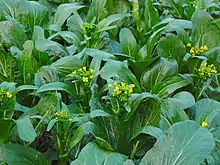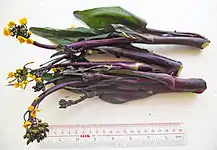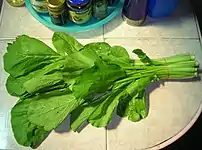Choy sum
Choy sum (also spelled choi sum or "cai xin" using Pinyin) is a leafy vegetable commonly used in Chinese cuisine. It is a member of the genus Brassica of the mustard family, Brassicaceae (Brassica rapa var. parachinensis or Brassica chinensis var. parachinensis). Choy sum is a transliteration of the Cantonese name (Chinese: 菜心), which can be literally translated as "heart of the vegetable". It is also known as Chinese flowering cabbage.[1]
| Choy sum / Cai Xin | |
|---|---|
 Choy sum plants, growing on a farm | |
| Species | Brassica rapa var. parachinensis |
| Cultivar group | Chinensis, Pekinensis groups |
| Origin | China, before the 15th Century |
| Cultivar group members | Many; see text. |
| Choy sum (Cai Xin) / 小芥蘭 | |||||||||||||||||||
|---|---|---|---|---|---|---|---|---|---|---|---|---|---|---|---|---|---|---|---|
| Chinese | 菜心 / 小芥蘭 | ||||||||||||||||||
| Hanyu Pinyin | càixīn | ||||||||||||||||||
| Jyutping | coi3 sam1 | ||||||||||||||||||
| |||||||||||||||||||
Description
Choy sum is a green leafy vegetable similar to gai lan, and can be characterized by the distinct yellow flowers which it bears. Each flower has four yellow, oval to round petals with six stamens on fleshy, erect stems which are 0.5 to 1 centimetre (1⁄4 to 1⁄2 inch) in diameter and 15 to 20 cm (6 to 8 in) tall with light to dark green, and are oval (becomes acuminate shaped, or basal-shaped near the flowering stage) with slightly serrated margins leaves, which never forms compact heads like the cabbage. Fruits can develop out of cross-pollination or self-pollination, and are silique structured, that open at maturity through dehiscence or drying to bare open to brown or black seeds that are small and round in shape. A single pod can bear up to 4 to 46 seeds.
The height of the plant varies greatly, ranging from 10 to 40 cm (4 to 16 in) depending on the growing conditions and the variety. Flowering usually appears when there are about 7 to 8 leaves on the plant or about 20 cm (8 in) tall. The bulk of the root system is found within a depth of 12 cm (4 1⁄2 in) and is confined to a radius of 12 cm (4 1⁄2 in).[2][3]
The whole plant is overall an annual, herbaceous plant, rarely perennial, rarely growing into subshrubs. The whole plant consists of a simple or branched (when it is near the flowering stage), leafy structure. It grows best in soil with a minimum pH level of 5.6, maximum pH level of 7.5.[4]
Gallery
 Purple Choi Sum
Purple Choi Sum
See also
References
| Wikimedia Commons has media related to Brassica rapa subsp. chinensis var. parachinensis. |
- "Archived copy". Archived from the original on 2013-02-08. Retrieved 2013-04-18.CS1 maint: archived copy as title (link)
- Resources, Department of Economic Development, Jobs, Transport and (2017-05-22). "Agriculture". www.dpi.vic.gov.au.
- "Archived copy". Archived from the original on 2013-02-26. Retrieved 2013-02-17.CS1 maint: archived copy as title (link)
- http://zipcodezoo.com/Plants/B/Brassica_chinensis_var__parachinensis/%5B%5D